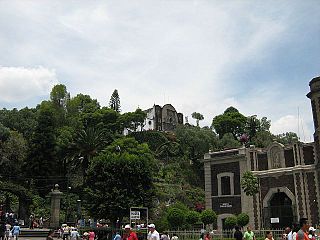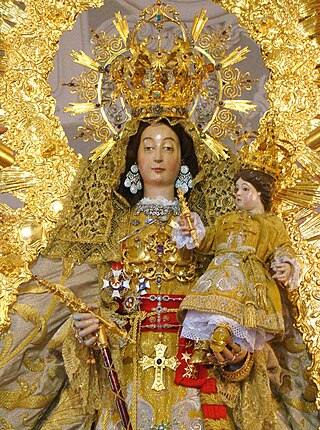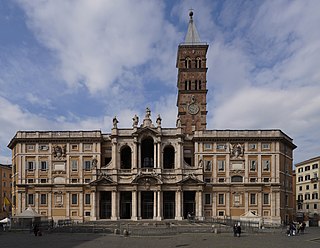
Our Lady of Guadalupe, also known as the Virgin of Guadalupe, is a Catholic title of the Blessed Virgin Mary associated with four Marian apparitions to Juan Diego and one to his uncle, Juan Bernardino reported in December 1531, when the Mexican territories were part of the Spanish Empire.

The Basilica of Santa María de Guadalupe, officially called Insigne y Nacional Basílica de Santa María de Guadalupe is a basilica of the Catholic Church, dedicated to the Virgin Mary in her invocation of Our Lady of Guadalupe, located at the foot of the Hill of Tepeyac in the Gustavo A. Madero borough of Mexico City. It belongs to the Primate Archdiocese of Mexico through the Guadalupana Vicariate, which since November 4, 2018, is in the care of Monsignor Efraín Hernández Díaz, who has the title of general and episcopal vicar of Guadalupe and abbot of the basilica.
Juan Diego Bernardino was one of two Aztec peasants alleged to have had visions of the Virgin Mary as Our Lady of Guadalupe in 1531.

Huei Tlamahuiçoltica is a tract in Nahuatl comprising 36 pages and was published in Mexico City, Mexico in 1649 by Luis Laso de la Vega, the vicar of the chapel of Our Lady of Guadalupe at Tepeyac outside the same city. In the preface Luis Laso de la Vega claimed authorship of the whole work, but this claim is the subject of an ongoing difference of scholarly opinion.

Tepeyac or the Hill of Tepeyac, historically known by the names Tepeyacac and Tepeaquilla, is located inside Gustavo A. Madero, the northernmost Alcaldía or borough of Mexico City. According to the Catholic tradition, it is the site where Saint Juan Diego met the Virgin of Guadalupe in December 1531, and received the iconic image of the Lady of Guadalupe. The Basilica of Our Lady of Guadalupe located there is one of the most visited Catholic shrines in the world. Spanish colonists erected a Catholic chapel at the site, Our Lady of Guadalupe, "the place of many miracles." It forms part of the Sierra de Guadalupe mountain range.

The Catholic Church during the Age of Discovery inaugurated a major effort to spread Christianity in the New World and to convert the indigenous peoples of the Americas and other indigenous peoples. The evangelical effort was a major part of, and a justification for, the military conquests of European powers such as Portugal, Spain, and France. Christian missions to the indigenous peoples ran hand-in-hand with the colonial efforts of Catholic nations. In the Americas and other colonies in Asia, and Africa, most missions were run by religious orders such as the Franciscans, Dominicans, Augustinians, and Jesuits. In Mexico, the early systematic evangelization by mendicants came to be known as the "Spiritual Conquest of Mexico".
Stafford Poole, C.M was a Vincentian Catholic priest and a research historian. He was a former professor of history at the former St. John's Seminary College in Camarillo, California and later served as president. The college closed in 2002. He is also known for his extensive writings about the history of the Catholic Church in Mexico and the devotion to the Virgin of Guadalupe.
Because Juan Diego did not speak Spanish, it has been proposed by multiple authors and analysts that the name Guadalupe, referring to the Virgin of Guadalupe, was likely derived from a word in the Nahuatl language.

The Basilica of Guadalupe or Santuario de Nuestra Señora de Guadalupe is a Roman Catholic church located in the metropolitan area of Monterrey, Nuevo León, Mexico.

The Basilica of Our Lady of Zapopan and the abbey of the same name are a 17th-century Franciscan sanctuary built in downtown Zapopan, in the state of Jalisco, Mexico.

The Virgin of Los Remedios or Our Lady of Los Remedios is a title of the Virgin Mary developed by the Trinitarian Order, founded in the late 12th century. The devotion became tied to the Reconquista of Spain, then still at its height. In the following century it spread to other parts of Europe. When Spain began the exploration and conquest of the Americas, it was a favorite devotion of the Spanish conquistadores. It remains a popular devotion in Spain and Latin America.

Catholic Marian churches are religious buildings dedicated to the veneration of the Blessed Virgin Mary. These churches were built throughout the history of the Catholic Church, and today they can be found on every continent including Antarctica. The history of Marian church architecture tells the unfolding story of the development of Catholic Mariology.

The Virgin of Candelaria or Our Lady of Candelaria, popularly called La Morenita, celebrates the Virgin Mary on the island of Tenerife, one of the Canary Islands (Spain). The center of worship is located in the city of Candelaria in Tenerife. She is depicted as a Black Madonna. The "Royal Basilica Marian Shrine of Our Lady of Candelaria" is considered the main church dedicated to the Virgin Mary in the Canary Islands and she is the patroness saint of the Canary Islands. Her feast is celebrated on February 2 and August 15, the patronal feast of the Canary Islands.
Informaciones Jurídicas de 1666 is a Spanish document that helped support the apparition of the Virgin Mary to Juan Diego Cuauhtlatoatzin at the hill of Tepeyac in 1531. The apparition is also known today as the iconic Virgin of Guadalupe. The Proceedings of 1666 consist of a series of investigations, record examinations, testimonies from artists, physicians, and Aztec historians, and oral accounts from elderly men and women who had knowledge and experience with Juan Diego and his contemporaries.

Within Catholicism, a miracle of the roses is a miracle in which roses manifest an activity of God or a saint. Such a miracle is presented in various hagiographies and legends in different forms, and it occurs in connection with diverse individuals such as Saints Elizabeth of Hungary (1207–1231), Elizabeth of Portugal (1271–1336), Saint Dorothy, a 4th-century virgin martyr at Caesarea in Cappadocia, and Our Lady of Guadalupe.
The Puerto Rican Episcopal Conference (CEP) is the episcopal conference of the Roman Catholic bishops of Puerto Rico, a territory of the United States.

Juan Diego Cuauhtlatoatzin (1474–1548), also known simply as Juan Diego, was a Nahua peasant and Marian visionary. He is said to have been granted apparitions of Our Lady of Guadalupe on four occasions in December 1531: three at the hill of Tepeyac and a fourth before don Juan de Zumárraga, then the first bishop of Mexico. The Basilica of Our Lady of Guadalupe, located at the foot of Tepeyac, houses the cloak (tilmahtli) that is traditionally said to be Juan Diego's, and upon which the image of the Virgin is said to have been miraculously impressed as proof of the authenticity of the apparitions.

Alma López is a Mexican-born Queer Chicana artist. Her art often portrays historical and cultural Mexican figures, such as the Virgin of Guadalupe and La Llorona, filtered through a radical Chicana feminist lesbian lens. Her art work is meant to empower women and indigenous Mexicans by the reappropriation of symbols of Mexica history when women played a more prominent role. The medium of digital art allows her to mix different elements from Catholicism and juxtapose it to indigenous art, women, and issues such as rape, gender violence, sexual marginalization and racism. This juxtaposition allows her to explore the representation of women and indigenous Mexicans and their histories that have been lost or fragmented since colonization. Her work is often seen as controversial. Currently, she is a lecturer at the University of California Los Angeles in the Department of Chicana/o Studies.

Chicana literature is a form of literature that has emerged from the Chicana Feminist movement. It aims to redefine Chicana archetypes, in an effort to provide positive models for Chicanas. Chicana writers redefine their relationships with what Gloria Anzaldúa has called "Las Tres Madres" of Mexican culture, by depicting them as feminist sources of strength and compassion.




















